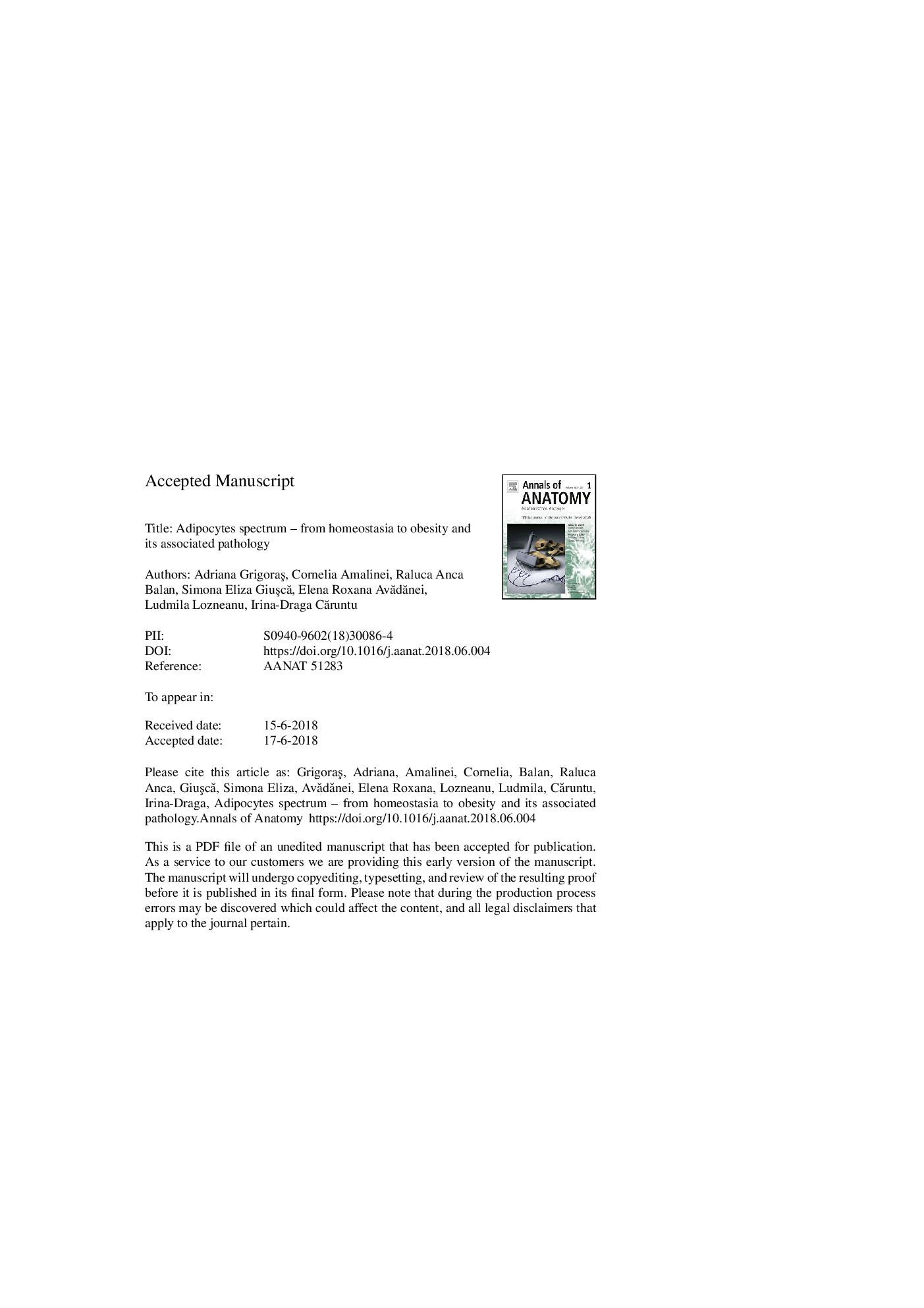| Article ID | Journal | Published Year | Pages | File Type |
|---|---|---|---|---|
| 8460233 | Annals of Anatomy - Anatomischer Anzeiger | 2018 | 71 Pages |
Abstract
Firstly identified by anatomists, the fat tissue is nowadays an area of intense research due to increased global prevalence of obesity and its associated diseases. Histologically, there are four types of fat tissue cells which are currently recognized (white, brown, beige, and perivascular adipocytes). Therefore, in this study we are reviewing the most recent data regarding the origin, structure, and molecular mechanisms involved in the development of adipocytes. White adipocytes can store triglycerides as a consequence of lipogenesis, under the regulation of growth hormone or leptin and adiponectin, and release fatty acids resulted from lipolysis, under the regulation of the sympathetic nervous system, glucocorticoids, TNF-α, insulin, and natriuretic peptides. Brown adipocytes possess a mitochondrial transmembrane protein thermogenin or UCP1 which allows heat generation. Recently, thermogenic, UCP positive adipocytes have been identified in the subcutaneous white adipose tissue and have been named beige adipocytes. The nature of these cells is still controversial, as current theories are suggesting their origin either by transdifferentiation of white adipocytes, or by differentiation from an own precursor cell. Perivascular adipocytes surround most of the arteries, exhibiting a supportive role and being involved in the maintenance of intravascular temperature. Thoracic perivascular adipocytes resemble brown adipocytes, while abdominal ones are more similar to white adipocytes and, consequently, are involved in obesity-induced inflammatory reactions. The factors involved in the regulation of adipose stem cells differentiation may represent potential pathways to inhibit or to divert adipogenesis. Several molecules, such as pro-adipogenic factors (FGF21, BMP7, BMP8b, and Cox-2), cell surface proteins or receptors (Asc-1, PAT2, P2RX5), and hypothalamic receptors (MC4R) have been identified as the most promising targets for the development of future therapies. Further investigations are necessary to complete the knowledge about adipose tissue and the development of a new generation of therapeutic tools based on molecular targets.
Keywords
CREBCDKASPCOX-218F-fluorodeoxyglucoseFGFMIRMCP-1PPARγPOMCBATPRBIGF-IpKaGHRNGFFDGAP2SCA1pro-opiomelanocortinWntMC4RPAI-1NPRPET-CTARNTLRBP4EBFTbx1AQP7AdipoRLPLIRFIP-10RERHSLwingless-type MMTV integration site familyPDGFRαstem cell antigen 1Early B-cell factorPGC1αPVATMIP-1βPGI2G3PDHKLFPGF2αPLIN1CCAAT-enhancer-binding proteinsTCF21SHOX2UCPSREBP1FZD4DIO2Foxc2forkhead box C2Myf5FATP1NPY/AgRPPRDM16IMATPDK4RIP140PAXTMEMCIDEZIC1Angptl2Ob-RAsc-1Aquaporin-7GPR119Lhx8Tle3BMATTNFTGF-βLXRβhomeobox proteinKCNK3GATA binding proteinELOVL3serum amyloid A3receptor-interacting protein 140BDNFC/EBPC/EBP homologous proteinTGsTZDsAdipocytesALPAlkaline phosphataseGATAAngiotensin IIAngiotensinogenAtglinsulininsulin-like growth factor IinterleukinWhite adipose tissuebrown adipose tissuebone marrow adipose tissueperivascular adipose tissueSERTransforming growth factor βThermogenesispositron emission tomography-computed tomographyCHOPthiazolidinedionesAng IIadipose stem cellsAgecyclooxygenase 2body mass indexBMIrough endoplasmic reticulumsmooth endoplasmic reticuluminterferon regulatory factorMyogenic Factor 5Krüppel-like factorGranulocyte-colony stimulating factornerve growth factorfibroblast growth factorG-CSFtumor necrosis factoradipose triglyceride lipaseLipoprotein lipaseCARmacrophage inflammatory protein-1βBMPObesityMicroRNAPlasminogen activator inhibitor type 1monocyte chemoattractant protein 1Retinol-binding protein 4sterol regulatory element-binding protein 1interferon-γ-inducible protein 10Acylation stimulating proteinTransmembrane proteinUncoupling proteinfatty acid transport protein 1retinoblastoma proteinBone morphogenetic proteincAMP response element-binding proteinC-reactive proteinCRPprotein kinase AProstaglandin F2αProstaglandin I2Body fatWATAdiponectin genecyclin-dependent kinasePeroxisome proliferator-activated receptor gammaglyceraldehyde 3-phosphate dehydrogenaseadiponectin receptorPlatelet-derived growth factor receptor alphainsulin receptormelanocortin 4 receptorgrowth hormone receptorglucocorticoids receptor
Related Topics
Life Sciences
Biochemistry, Genetics and Molecular Biology
Cell Biology
Authors
Adriana GrigoraÅ, Cornelia Amalinei, Raluca Anca Balan, Simona Eliza GiuÅcÄ, Elena Roxana AvÄdÄnei, Ludmila Lozneanu, Irina-Draga CÄruntu,
